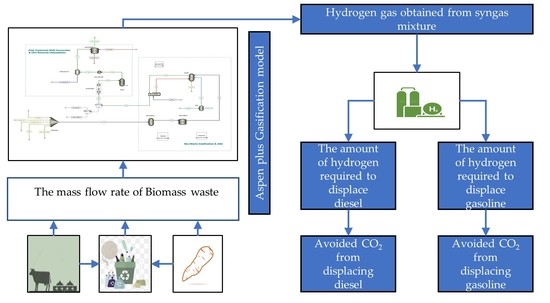Decarbonizing Vehicle Transportation with Hydrogen from Biomass Gasification: An Assessment in the Nigerian Urban Environment
Abstract
:1. Introduction
1.1. Literature Connected to This Study
1.2. Motivation for This Study
1.3. Novelty of This Work
- Simulating the biomass waste in six sites with various mass flow rates in Aspen Plus, to produce hydrogen.
- Analysis and comparison of the different sites using technical and environmental factors.
- Determining the effect of the optimum operating conditions on the amount of CO2 emissions from the road transport sector from the gasification process.
2. Biomass Waste to Energy for Transportation in Nigeria
3. Methodology
3.1. Estimating the Feedstock for Simulating the Biomass Gasification Model in Aspen Plus
3.1.1. Calculating the Input Value of Food Waste for the Aspen Plus Model
3.1.2. Estimating the Amount of Cow Dung
3.1.3. Estimating the Amount of Cassava-Peel Waste
3.2. Aspen Plus Simulation and Modelling
3.3. Estimating the Vehicle Stock
3.4. Vehicle Fleet Composition
3.5. Estimating the Amount of Gasoline Consumed
3.6. Estimating the Amount of Diesel Consumed
3.7. Calculating the CO2 Emissions
3.8. Estimating the Amount of Hydrogen Gas That Can Serve as a Substitute for an Equivalent Amount of Gasoline and Diesel Consumption in the Road Transport Sector
3.9. Calculating the Amount of Avoided CO2 Emissions
4. Results and Discussion
4.1. The Estimated Flow Rates Used in the Aspen Plus Model
4.2. Validating the Results of the Aspen Plus Model
4.3. Sensitivity Analysis
4.3.1. The Equivalence Ratio
4.3.2. Gasification Temperature
4.3.3. Steam-to-Biomass Ratio
4.4. Technical Assessment of the Hydrogen Production Sites/Cities
4.5. Environmental Assessment of the Hydrogen Production Sites/Cities
4.5.1. Amount of CO2 Emitted in the Transport Sector
4.5.2. The Amount of Avoided CO2 Emissions
4.6. Managerial Implication of Research
5. Conclusions
Author Contributions
Funding
Institutional Review Board Statement
Informed Consent Statement
Data Availability Statement
Acknowledgments
Conflicts of Interest
References
- Statistical Review of World Energy/Energy Economics/Home. Available online: https://www.bp.com/en/global/corporate/energy-economics/statistical-review-of-world-energy.html (accessed on 28 February 2022).
- Khan, M.K.; Khan, M.I.; Rehan, M. The relationship between energy consumption, economic growth and carbon dioxide emissions in Pakistan. Financ. Innov. 2020, 6, 1. [Google Scholar] [CrossRef] [Green Version]
- Harvey, L.D.D. Resource implications of alternative strategies for achieving zero greenhouse gas emissions from light-duty vehicles by 2060. Appl. Energy 2018, 212, 663–679. [Google Scholar] [CrossRef]
- CO2 Emissions—Global Energy Review 2021—Analysis—IEA. Available online: https://www.iea.org/reports/global-energy-review-2021/co2-emissions (accessed on 28 February 2022).
- Transport—Topics—IEA. Available online: https://www.iea.org/topics/transport (accessed on 28 February 2022).
- Use of Energy for Transportation—U.S. Energy Information Administration (EIA). Available online: https://www.eia.gov/energyexplained/use-of-energy/transportation.php (accessed on 28 February 2022).
- Primary and Final Energy Consumption in Europe. Available online: https://www.eea.europa.eu/ims/primary-and-final-energy-consumption-1 (accessed on 28 February 2022).
- Sharpe, B.E.N.; Muncrief, R. Literature Review: Real-World Fuel Consumption of Heavy-Duty Vehicles in the United States, China, and the European Union; International Council on Clean Transportation: Washington, DC, USA, 2015. [Google Scholar]
- Lopp, S.; Wood, E.; Duran, A. Evaluating the Impact of Road Grade on Simulated Commercial Vehicle Fuel Economy Using Real-World Drive Cycles; National Renewable Energy Lab. (NREL): Golden, CO, USA, 2015. [Google Scholar]
- About the OECD—OECD. Available online: https://www.oecd.org/about/ (accessed on 20 March 2022).
- Čižinská, R.; Chládková, J. Selected Impacts of Regulation (EU) 2019/631 On Value Creation in the Automative Industry. Financ. Int. Q. 2021, 17, 76–87. [Google Scholar] [CrossRef]
- Commission, E.-E. Regulation (EU) 2019/631 of the European parliament and of the council of 17 April 2019 setting CO2 emission performance standards for new passenger cars and for new light commercial vehicles, and repealing Regulations (EC) No 443/2009 and (EU) No 510/201. Off. J. Eur. Union L 2019, 111, 13–53. [Google Scholar]
- Ntziachristos, L.; Samaras, Z. Air Pollutant Emission Inventory Guidebook Guidebook 2019 (1. A. 3. b); European Environmental Agency: Copenhagen, Denmark, 2019; Volume 8, pp. 1–58. [Google Scholar]
- European Commission. Choose your language/Choisir une langue/Wählen Sie eine Sprache. Available online: https://ec.europa.eu/ (accessed on 19 March 2022).
- The Road Vehicle Carbon Dioxide Emission Performance Standards (Cars and Vans) (Amendment) (EU Exit) Regulations 2020. Available online: https://www.legislation.gov.uk/ukdsi/2020/9780348213485 (accessed on 23 February 2022).
- Sun, S.; Zhao, G.; Wang, T.; Jin, J.; Wang, P.; Lin, Y.; Li, H.; Ying, Q.; Mao, H. Past and future trends of vehicle emissions in Tianjin, China, from 2000 to 2030. Atmos. Environ. 2019, 209, 182–191. [Google Scholar] [CrossRef]
- Brand, C.; Anable, J.; Ketsopoulou, I.; Watson, J. Road to zero or road to nowhere? Disrupting transport and energy in a zero carbon world. Energy Policy 2020, 139, 111334. [Google Scholar] [CrossRef]
- Trends and Developments in Electric Vehicle Markets—Global EV Outlook 2021—Analysis—IEA. Available online: https://www.iea.org/reports/global-ev-outlook-2021/trends-and-developments-in-electric-vehicle-markets (accessed on 14 April 2022).
- Rokicki, T.; Bórawski, P.; Bełdycka-Bórawska, A.; Żak, A.; Koszela, G. Development of Electromobility in European Union Countries under COVID-19 Conditions. Energies 2021, 15, 9. [Google Scholar] [CrossRef]
- Łuszczyk, M.; Sulich, A.; Siuta-Tokarska, B.; Zema, T.; Thier, A. The Development of Electromobility in the European Union: Evidence from Poland and Cross-Country Comparisons. Energies 2021, 14, 8247. [Google Scholar] [CrossRef]
- Mali, B.; Shrestha, A.; Chapagain, A.; Bishwokarma, R.; Kumar, P.; Gonzalez-Longatt, F. Challenges in the penetration of electric vehicles in developing countries with a focus on Nepal. Renew. Energy Focus 2022, 40, 1–12. [Google Scholar] [CrossRef]
- Ballo, A.; Valentin, K.K.; Korgo, B.; Ogunjobi, K.O.; Agbo, S.N.; Kone, D.; Savadogo, M. Law and Policy Review on Green Hydrogen Potential in ECOWAS Countries. Energies 2022, 15, 2304. [Google Scholar] [CrossRef]
- Ball, M.; Weeda, M. 11-The hydrogen economy—Vision or reality? Compend. Hydrog. Energy 2016, 4, 237–266. [Google Scholar]
- Akal, D.; Öztuna, S.; Büyükakın, M.K. A review of hydrogen usage in internal combustion engines (gasoline-Lpg-diesel) from combustion performance aspect. Int. J. Hydrog. Energy 2020, 45, 35257–35268. [Google Scholar] [CrossRef]
- González-Velasco, J.R.; Pereda-Ayo, B.; De-La-Torre, U.; Urrutxua, M.; López-Fonseca, R. NOx Storage and Reduction Coupled with Selective Catalytic Reduction for NOx Removal in Light-Duty Vehicles. ChemCatChem 2018, 10, 2928–2940. [Google Scholar] [CrossRef]
- Ayodele, T.R.; Alao, M.A.; Ogunjuyigbe, A.S.O.; Munda, J.L. Electricity generation prospective of hydrogen derived from biogas using food waste in south-western Nigeria. Biomass Bioenergy 2019, 127, 105291. [Google Scholar] [CrossRef]
- The Future of Hydrogen—Analysis—IEA. Available online: https://www.iea.org/reports/the-future-of-hydrogen (accessed on 23 February 2022).
- Hydrogen Production Cost Analysis/Hydrogen and Fuel Cells/NREL. Available online: https://www.nrel.gov/hydrogen/production-cost-analysis.html (accessed on 23 February 2022).
- Rezaei, M.; Mostafaeipour, A.; Qolipour, M.; Momeni, M. Energy supply for water electrolysis systems using wind and solar energy to produce hydrogen: A case study of Iran. Front. Energy 2019, 13, 539–550. [Google Scholar] [CrossRef]
- Mutlu, Ö.Ç.; Zeng, T. Challenges and opportunities of modeling biomass gasification in Aspen Plus: A review. Chem. Eng. Technol. 2020, 43, 1674–1689. [Google Scholar] [CrossRef]
- Molino, A.; Chianese, S.; Musmarra, D. Biomass gasification technology: The state of the art overview. J. Energy Chem. 2016, 25, 10–25. [Google Scholar] [CrossRef]
- Cerone, N.; Zimbardi, F. Effects of oxygen and steam equivalence ratios on updraft gasification of biomass. Energies 2021, 14, 2675. [Google Scholar] [CrossRef]
- Saleh, S.; Samad, N.A.F.A. Effects of Gasification Temperature and Equivalence Ratio on Gasification Performance and Tar Generation of Air Fluidized Bed Gasification Using Raw and Torrefied Empty Fruit Bunch. Chem. Eng. Trans. 2021, 88, 1309–1314. [Google Scholar]
- Fremaux, S.; Beheshti, S.-M.; Ghassemi, H.; Shahsavan-Markadeh, R. An experimental study on hydrogen-rich gas production via steam gasification of biomass in a research-scale fluidized bed. Energy Convers. Manag. 2015, 91, 427–432. [Google Scholar] [CrossRef]
- Keche, A.J.; Gaddale, A.P.R.; Tated, R.G. Simulation of biomass gasification in downdraft gasifier for different biomass fuels using ASPEN PLUS. Clean Technol. Environ. Policy 2015, 17, 465–473. [Google Scholar] [CrossRef]
- Han, J.; Liang, Y.; Hu, J.; Qin, L.; Street, J.; Lu, Y.; Yu, F. Modeling downdraft biomass gasification process by restricting chemical reaction equilibrium with Aspen Plus. Energy Convers. Manag. 2017, 153, 641–648. [Google Scholar] [CrossRef]
- Safarian, S.; Richter, C.; Unnthorsson, R. Waste Biomass Gasification Simulation Using Aspen Plus: Performance Evaluation of Wood Chips, Sawdust and Mixed Paper Wastes; Scientific Research Publishing: Wuhan, China, 2019. [Google Scholar]
- Timsina, R.; Thapa, R.K.; Eikeland, M.S. Aspen Plus simulation of biomass gasification for different types of biomass. Linköping Electron. Conf. Proc. 2019, 170, 151–157. [Google Scholar]
- Marcantonio, V.; Monarca, D.; Villarini, M.; Di Carlo, A.; Del Zotto, L.; Bocci, E. Biomass Steam Gasification, High-Temperature Gas Cleaning, and SOFC Model: A Parametric Analysis. Energies 2020, 13, 5936. [Google Scholar] [CrossRef]
- Kaushal, P.; Tyagi, R. Advanced simulation of biomass gasification in a fluidized bed reactor using ASPEN PLUS. Renew. Energy 2017, 101, 629–636. [Google Scholar] [CrossRef]
- Bijesh, R.; Arun, P.; Muraleedharan, C. Modified stoichiometric equilibrium model for sewage sludge gasification and its validation based on experiments in a downdraft gasifier. Biomass Convers. Biorefinery 2021, 1–21. [Google Scholar] [CrossRef]
- Pilar González-Vázquez, M.; Rubiera, F.; Pevida, C.; Pio, D.T.; Tarelho, L.A.C. Thermodynamic analysis of biomass gasification using aspen plus: Comparison of stoichiometric and non-stoichiometric models. Energies 2021, 14, 189. [Google Scholar] [CrossRef]
- Babatunde, O.M.; Munda, J.L.; Hamam, Y. Selection of a hybrid renewable energy systems for a low-income household. Sustainability 2019, 11, 4282. [Google Scholar] [CrossRef] [Green Version]
- Lan, W.; Chen, G.; Zhu, X.; Wang, X.; Liu, C.; Xu, B. Biomass gasification-gas turbine combustion for power generation system model based on ASPEN PLUS. Sci. Total Environ. 2018, 628, 1278–1286. [Google Scholar] [CrossRef]
- Salman, C.A.; Omer, C.B. Process modelling and simulation of waste gasification-based flexible polygeneration facilities for power, heat and biofuels production. Energies 2020, 13, 4264. [Google Scholar] [CrossRef]
- Niu, M.; Xie, J.; Liang, S.; Liu, L.; Wang, L.; Peng, Y. Simulation of a new biomass integrated gasification combined cycle (BIGCC) power generation system using Aspen Plus: Performance analysis and energetic assessment. Int. J. Hydrog. Energy 2021, 46, 22356–22367. [Google Scholar] [CrossRef]
- Hamrang, F.; Shokri, A.; Mahmoudi, S.M.; Ehghaghi, B.; Rosen, M.A. Performance analysis of a new electricity and freshwater production system based on an integrated gasification combined cycle and multi-effect desalination. Sustainability 2020, 12, 7996. [Google Scholar] [CrossRef]
- Kowsari, S.; Deymi-Dashtebayaz, M.; Karbasi, K.; Sheikhani, H. Optimal working conditions of various city gate stations for power and hydrogen production based on energy and eco-exergy analysis. Int. J. Hydrog. Energy 2020, 45, 22513–22533. [Google Scholar] [CrossRef]
- Hekmatshoar, M.; Deymi-Dashtebayaz, M.; Gholizadeh, M.; Dadpour, D.; Delpisheh, M. Thermoeconomic analysis and optimization of a geothermal-driven multi-generation system producing power, freshwater, and hydrogen. Energy 2022, 247, 123434. [Google Scholar] [CrossRef]
- AlNouss, A.; McKay, G.; Al-Ansari, T. Enhancing waste to hydrogen production through biomass feedstock blending: A techno-economic-environmental evaluation. Appl. Energy 2020, 266, 114885. [Google Scholar] [CrossRef]
- SDG Indicators. Available online: https://unstats.un.org/sdgs/report/2019/goal-11 (accessed on 11 March 2022).
- Trends in Solid Waste Management. Available online: https://datatopics.worldbank.org/what-a-waste/trends_in_solid_waste_management.html (accessed on 27 February 2022).
- Olanrewaju, F.O.; Andrews, G.E.; Li, H.; Phylaktou, H.N. Bioenergy potential in Nigeria. Chem. Eng. Trans. 2019, 74, 61–66. [Google Scholar]
- Nigeria at a glance/FAO in Nigeria/Food and Agriculture Organization of the United Nations. Available online: https://www.fao.org/nigeria/fao-in-nigeria/nigeria-at-a-glance/en/ (accessed on 23 February 2022).
- Africa Sustainable Livestock 2050. Available online: https://www.fao.org/documents/card/en/c/a2871dc7-7691-4779-94ae-3b10d22ad5fb/ (accessed on 23 February 2022).
- Ikuemonisan, E.S.; Mafimisebi, T.E.; Ajibefun, I.; Adenegan, K. Cassava production in Nigeria: Trends, instability and decomposition analysis (1970–2018). Heliyon 2020, 6, e05089. [Google Scholar] [CrossRef]
- Ben-Iwo, J.; Manovic, V.; Longhurst, P. Biomass resources and biofuels potential for the production of transportation fuels in Nigeria. Renew. Sustain. Energy Rev. 2016, 63, 172–192. [Google Scholar] [CrossRef] [Green Version]
- Adekunle, A.; Orsat, V.; Raghavan, V. Lignocellulosic bioethanol: A review and design conceptualization study of production from cassava peels. Renew. Sustain. Energy Rev. 2016, 64, 518–530. [Google Scholar] [CrossRef]
- Okike, I.; Samireddypalle, A.; Kaptoge, L.; Fauquet, C.; Atehnkeng, J.; Bandyopadhyay, R.; Kulakow, P.; Duncan, A.; Alabi, T.; Blummel, M. Technical innovations for small-scale producers and households to process wet cassava peels into high quality animal feed ingredients and aflasafeTM substrate. Food Chain 2015, 5, 71–90. [Google Scholar] [CrossRef]
- Ezeudu, O.B.; Agunwamba, J.C.; Ugochukwu, U.C.; Ezeudu, T.S. Temporal assessment of municipal solid waste management in Nigeria: Prospects for circular economy adoption. Rev. Environ. Health 2020, 36, 327–344. [Google Scholar] [CrossRef] [PubMed]
- Izah, S.C.; Angaye, T.C.N.; Ohimain, E.I. Environmental Impacts of Oil palm processing in Nigeria. Biotechnol. Res. 2016, 2, 132–141. [Google Scholar]
- Jekayinfa, S.O.; Orisaleye, J.I.; Pecenka, R. An assessment of potential resources for biomass energy in Nigeria. Resources 2020, 9, 92. [Google Scholar] [CrossRef]
- NNPC Reports—Audited Financial Statements, Monthly Performance Reports, FAAC Reports and More. Available online: https://nnpcgroup.com/NNPC-Business/Business-Information/Pages/Monthly-Performance-Data.aspx (accessed on 23 February 2022).
- Interrogating NNPC’s Fuel Consumption Figures/THISDAYLIVE. Available online: https://www.thisdaylive.com/index.php/2021/08/03/interrogating-nnpcs-fuel-consumption-figures/ (accessed on 20 March 2022).
- Daily Fuel Consumption Jumps to 72 Million Litres, Subsidy Hits N541.66bn—Punch Newspapers. Available online: https://punchng.com/daily-fuel-consumption-jumps-to-72-million-litres-subsidy-hits-n541-66bn/ (accessed on 20 March 2022).
- Elibrary | National Bureau of Statistics. Available online: https://nigerianstat.gov.ng/elibrary (accessed on 23 February 2022).
- Cervigni, R. Assessing Low-Carbon Development in Nigeria: An Analysis of Four Sectors; World Bank Publications: Washington, DC, USA, 2013; ISBN 082139973X. [Google Scholar]
- Omodero, C.O.; Ekwe, M.C.; Ihendinihu, J.U. The impact of internally generated revenue on economic development in Nigeria. Account. Financ. Res. 2018, 7, 103–114. [Google Scholar] [CrossRef] [Green Version]
- Census Enumeration—National Population Commission. Available online: https://nationalpopulation.gov.ng/core-activities/census-enumeration/ (accessed on 28 February 2022).
- Ogwueleka, T.C. Survey of household waste composition and quantities in Abuja, Nigeria. Resour. Conserv. Recycl. 2013, 77, 52–60. [Google Scholar] [CrossRef]
- Nwoke, O.A.; Okonkwo, W.I.; Echiegu, E.A.; Ugwuishiwu, B.O.; Okechukwu, C.H. Determination of the calorific value of municipal solid waste in enugu, nigeria and its potential for electricity generation. Agric. Eng. Int. CIGR J. 2020, 22, 86–97. [Google Scholar]
- Ibiebele, D.D. Rapid method for estimating solid wastes generation rate in developing countries. Waste Manag. Res. 1986, 4, 361–365. [Google Scholar] [CrossRef]
- Abah, S.O.; Ohimain, E.I. Assessment of dumpsite rehabilitation potential using the integrated risk based approach: A case study of Eneka, Nigeria. World Appl. Sci. J. 2010, 8, 436–442. [Google Scholar]
- Abd’Razack, N.T.A.; Medayese, S.O.; Shaibu, S.I.; Adeleye, B.M. Habits and benefits of recycling solid waste among households in Kaduna, North West Nigeria. Sustain. Cities Soc. 2017, 28, 297–306. [Google Scholar] [CrossRef]
- Ogunjuyigbe, A.S.O.; Ayodele, T.R.; Alao, M.A. Electricity generation from municipal solid waste in some selected cities of Nigeria: An assessment of feasibility, potential and technologies. Renew. Sustain. Energy Rev. 2017, 80, 149–162. [Google Scholar] [CrossRef]
- Babatunde, B.B.; Vincent-Akpu, I.F.; Woke, G.N.; Atarhinyo, E.; Aharanwa, U.C.; Green, A.F.; Isaac-Joe, O. Comparative analysis of municipal solid waste (MSW) composition in three local government areas in Rivers State, Nigeria. Afr. J. Environ. Sci. Technol. 2013, 7, 874–881. [Google Scholar]
- Fahim, M.A.; Alsahhaf, T.A.; Elkilani, A. Hydrogen production. In Fundamentals of Petroleum Refining; Elsevier: Amsterdam, The Netherlands, 2010; pp. 285–302. [Google Scholar]
- Ayodele, T.R.; Ogunjuyigbe, A.S.O.; Alao, M.A. Economic and environmental assessment of electricity generation using biogas from organic fraction of municipal solid waste for the city of Ibadan, Nigeria. J. Clean. Prod. 2018, 203, 718–735. [Google Scholar] [CrossRef]
- Ridha, F.N.; Manovic, V.; Macchi, A.; Anthony, E.J. CO2 capture at ambient temperature in a fixed bed with CaO-based sorbents. Appl. Energy 2015, 140, 297–303. [Google Scholar] [CrossRef]
- Doherty, W.; Reynolds, A.; Kennedy, D. Aspen Plus Simulation of Biomass Gasification in a Steam Blown Dual Fluidised Bed. Mendez-Vilas, A., Ed.; Formartex Research Centre: Badajoz, Spain, 2013. [Google Scholar]
- Shen, L.; Gao, Y.; Xiao, J. Simulation of hydrogen production from biomass gasification in interconnected fluidized beds. Biomass Bioenergy 2008, 32, 120–127. [Google Scholar] [CrossRef]
- Fonseca, J.; Albis, A.; Montenegro, A.R. Evaluation of zinc adsorption using cassava peels (Manihot esculenta) modified with citric acid. Contemp Eng. Sci 2018, 11, 3575–3585. [Google Scholar] [CrossRef] [Green Version]
- Yang, Y.; Heaven, S.; Venetsaneas, N.; Banks, C.J.; Bridgwater, A. V Slow pyrolysis of organic fraction of municipal solid waste (OFMSW): Characterisation of products and screening of the aqueous liquid product for anaerobic digestion. Appl. Energy 2018, 213, 158–168. [Google Scholar] [CrossRef]
- Akyürek, Z. Sustainable valorization of animal manure and recycled polyester: Co-pyrolysis synergy. Sustainability 2019, 11, 2280. [Google Scholar] [CrossRef] [Green Version]
- Maduekwe, M.; Akpan, U.; Isihak, S. Road transport energy consumption and vehicular emissions in Lagos, Nigeria: An application of the LEAP model. Transp. Res. Interdiscip. Perspect. 2020, 6, 100172. [Google Scholar] [CrossRef]
- United States, Environmental Protection Agency, Office of Mobile Sources, Emission Planning & Strategies Division. User’s Guide to MOBILE5:(Mobile Source Emission Factor Model); US Environmental Protection Agency: Washington, DC, USA, 1994.
- Andersson, J.; Grönkvist, S. Large-scale storage of hydrogen. Int. J. Hydrog. Energy 2019, 44, 11901–11919. [Google Scholar] [CrossRef]
- Alternative Fuels Data Center: Fuel Properties Comparison. Available online: https://afdc.energy.gov/fuels/properties (accessed on 28 February 2022).
- Niaz, S.; Manzoor, T.; Pandith, A.H. Hydrogen storage: Materials, methods and perspectives. Renew. Sustain. Energy Rev. 2015, 50, 457–469. [Google Scholar] [CrossRef]
- Gillingham, K. Hydrogen Internal Combustion Engine Vehicles: A Prudent Intermediate Step or A Step in the Wrong Direction; Department of Management Science & Engineering Global Climate and Energy Project Precourt Institute for Energy Efficiency of Stanford University: Stanford, CA, USA, 2007. [Google Scholar]
- Albatayneh, A.; Assaf, M.N.; Alterman, D.; Jaradat, M. Comparison of the overall energy efficiency for internal combustion engine vehicles and electric vehicles. Environ. Clim. Technol. 2020, 24, 669–680. [Google Scholar] [CrossRef]
- Hosseini, S.E.; Butler, B. An overview of development and challenges in hydrogen powered vehicles. Int. J. Green Energy 2020, 17, 13–37. [Google Scholar] [CrossRef] [Green Version]
- Fuel Gases—Heating Values. Available online: https://www.engineeringtoolbox.com/heating-values-fuel-gases-d_823.html (accessed on 23 February 2022).
- Lv, P.M.; Xiong, Z.H.; Chang, J.; Wu, C.Z.; Chen, Y.; Zhu, J.X. An experimental study on biomass air–steam gasification in a fluidized bed. Bioresour. Technol. 2004, 95, 95–101. [Google Scholar] [CrossRef] [PubMed]
- Liu, H.; Hu, J.; Wang, H.; Wang, C.; Li, J. Experimental studies of biomass gasification with air. J. Nat. Gas Chem. 2012, 21, 374–380. [Google Scholar] [CrossRef]
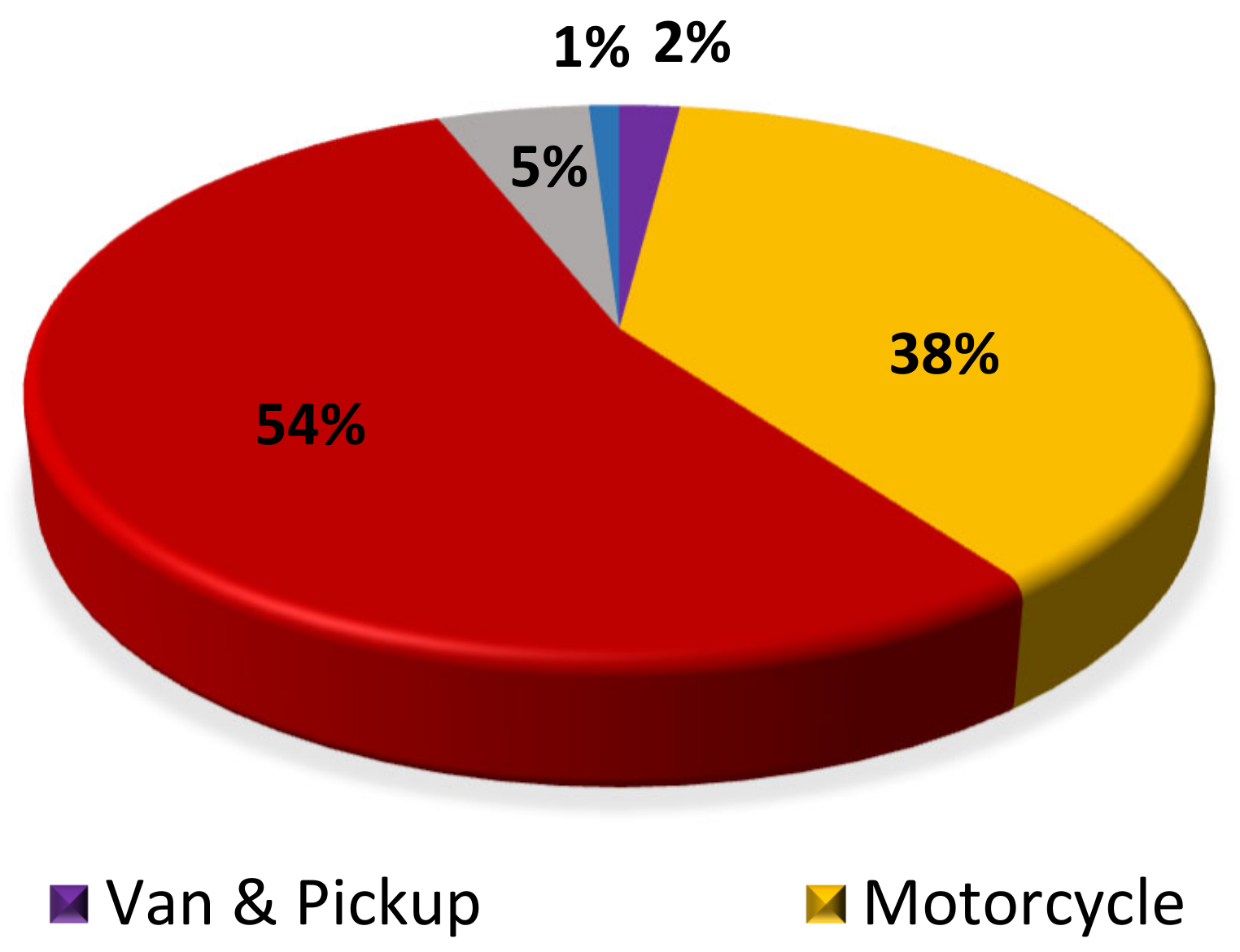

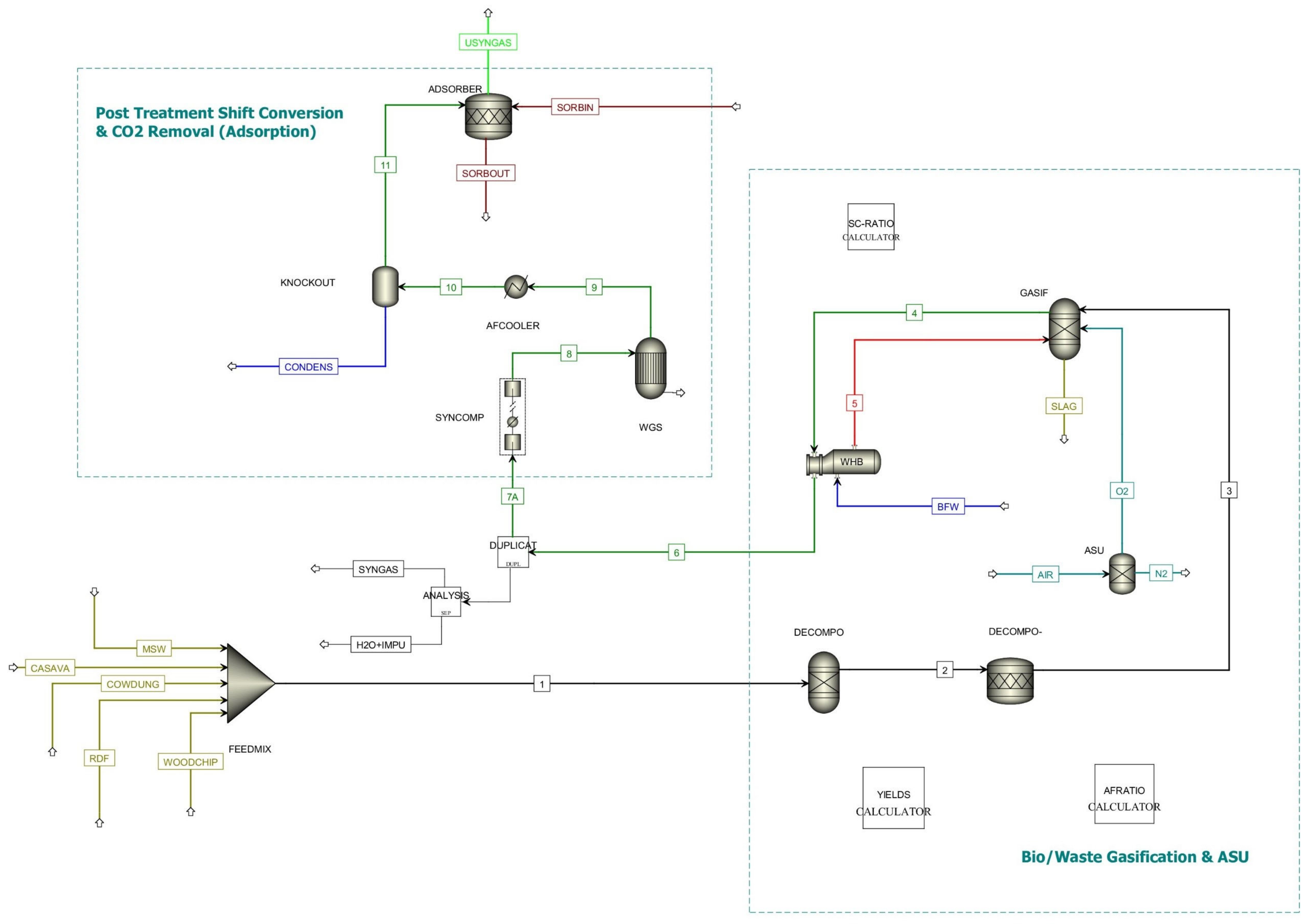
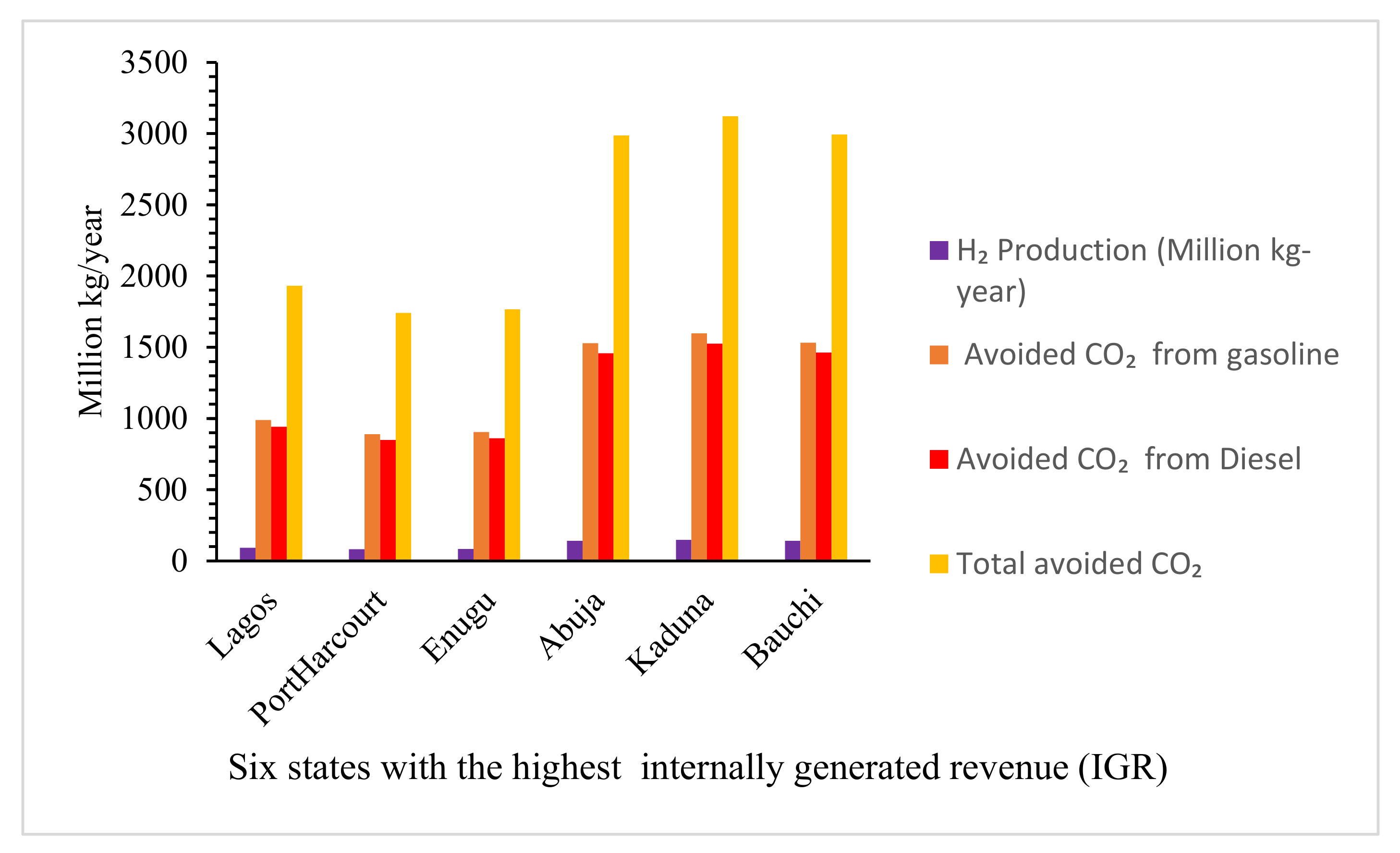
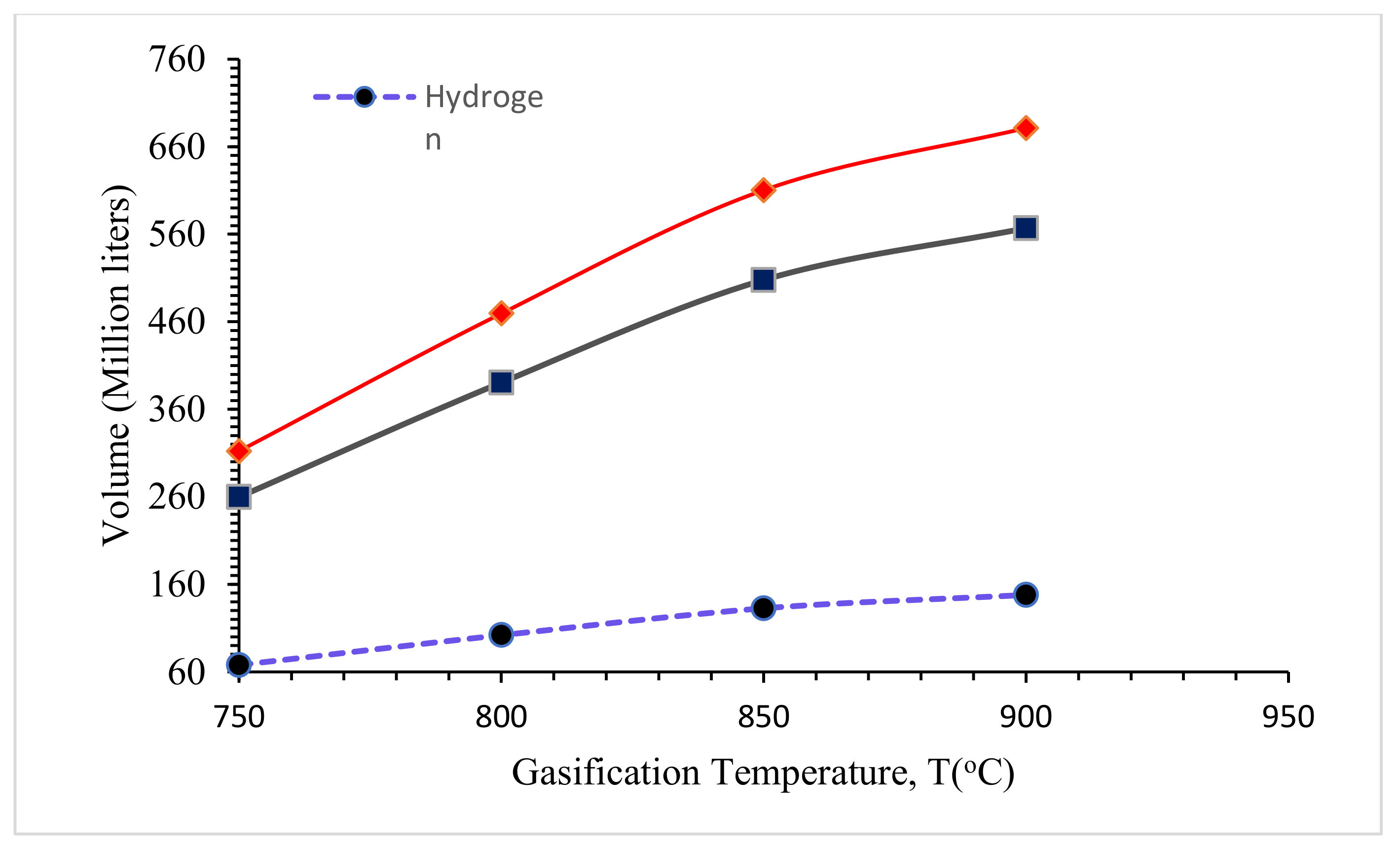


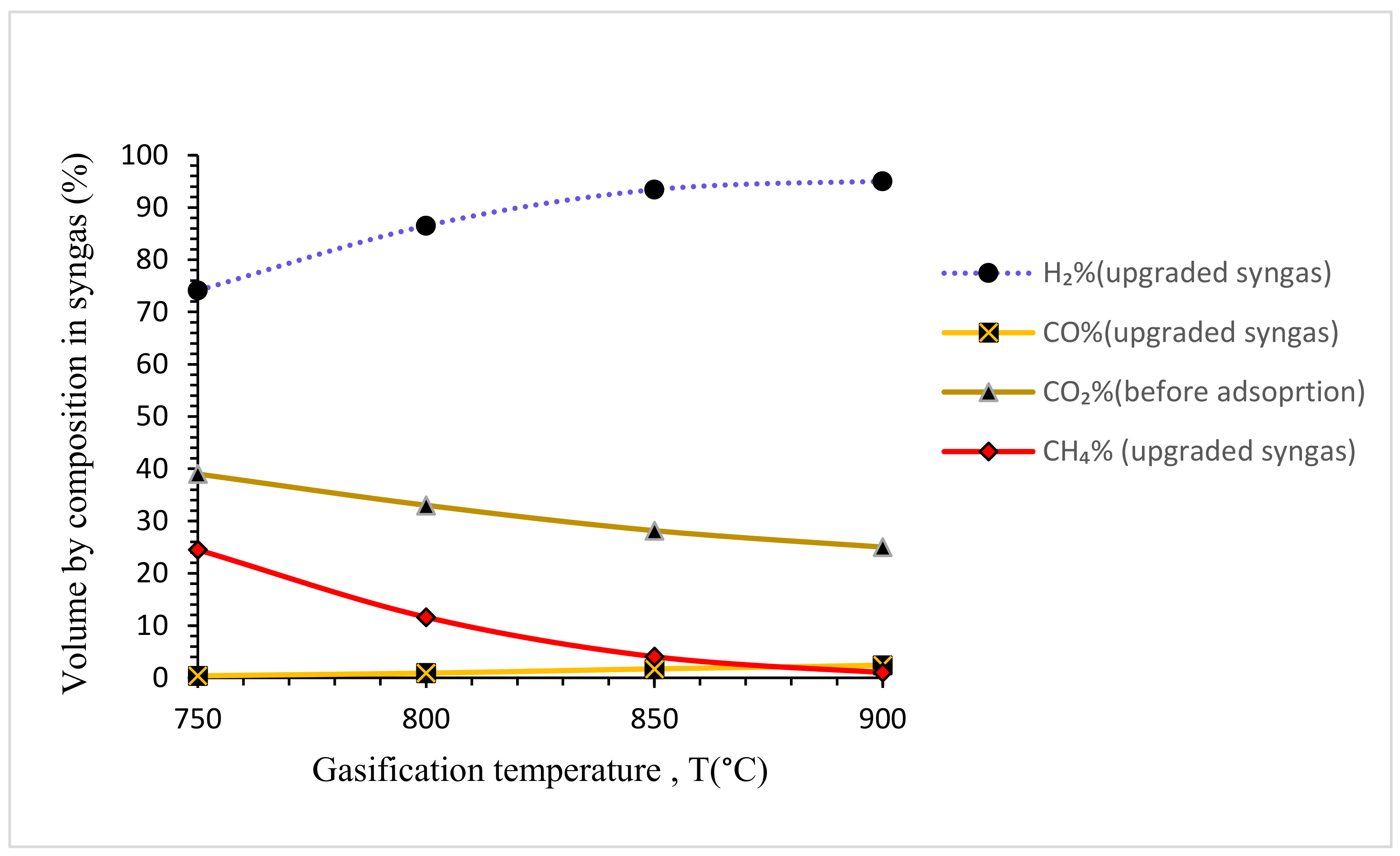
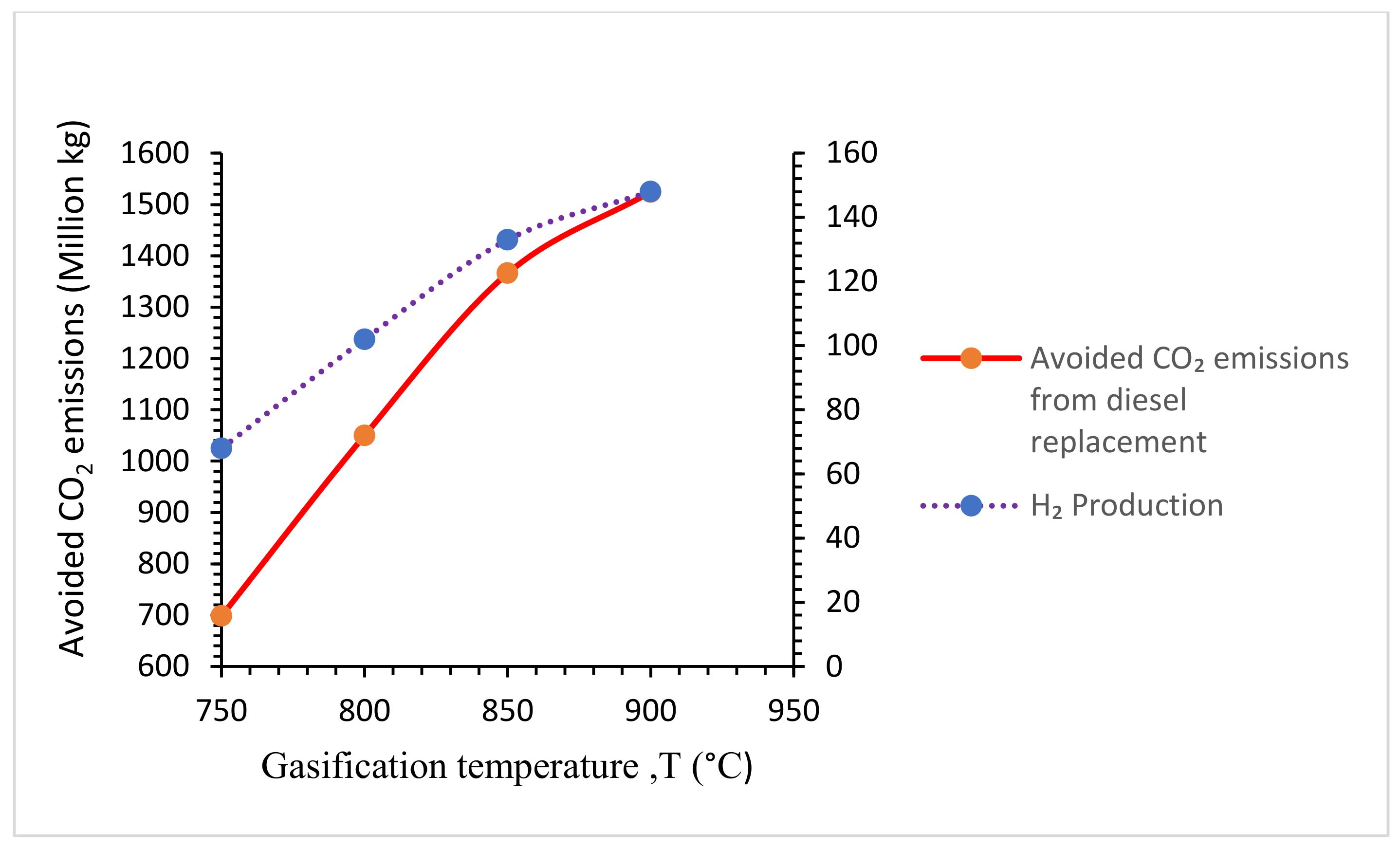
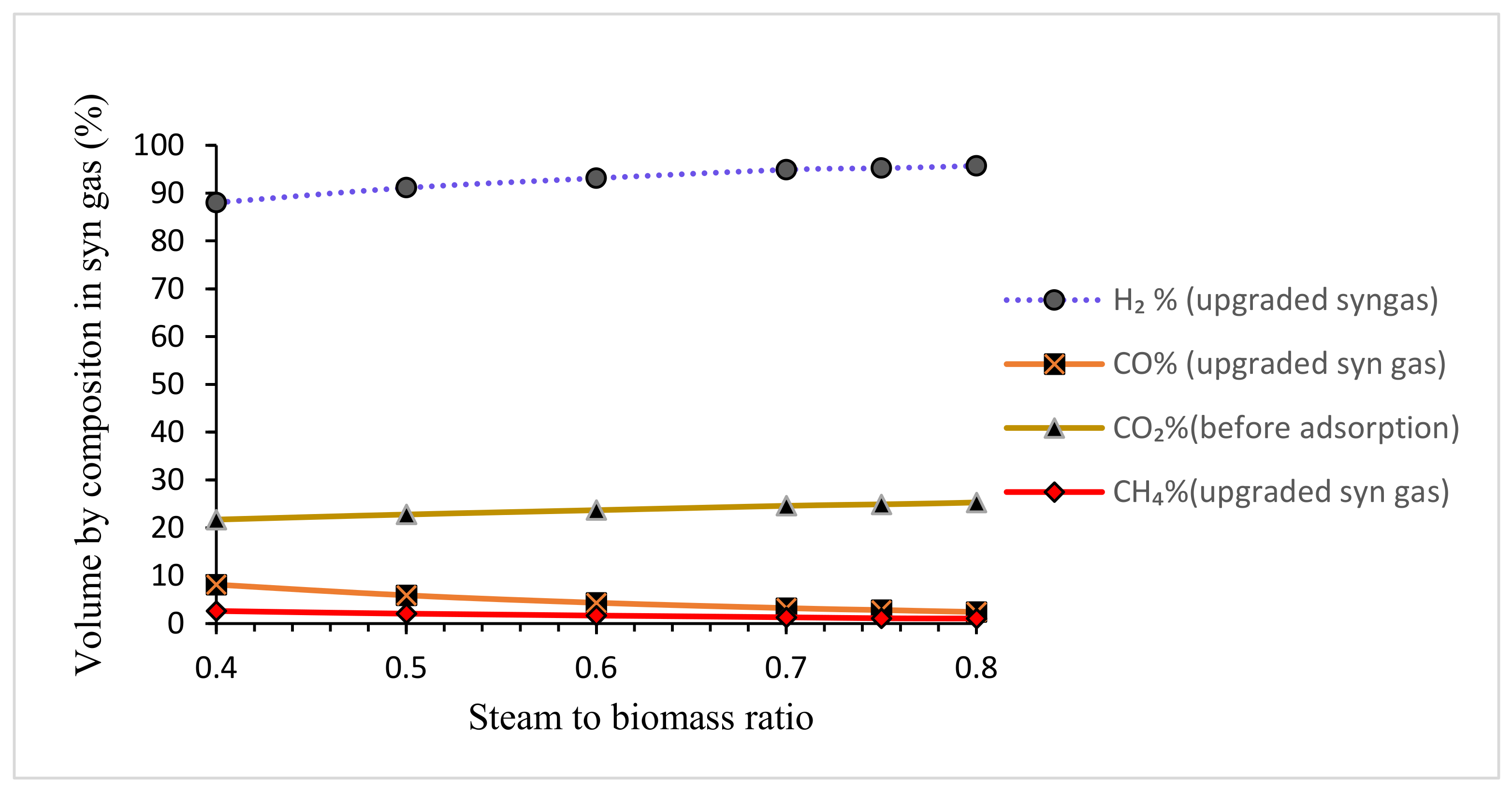
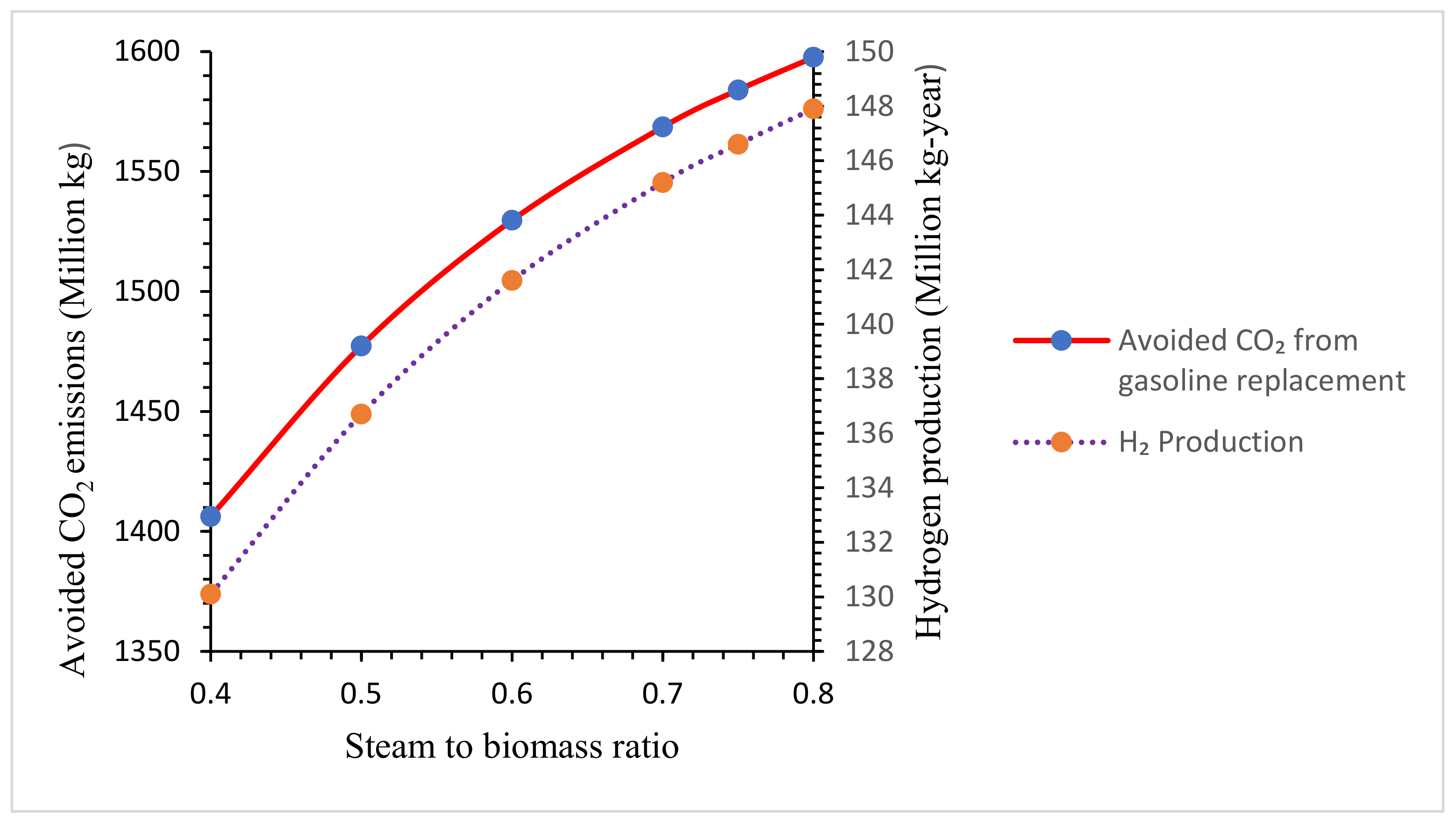
| Selected City | IGR [66] | Population (p) [69] | Vehicle Owners (v) v = p × 0.06 | Waste Generated per Capita (kg/Capita/Day) |
|---|---|---|---|---|
| Abuja | 69,072,879,664 | 1,406,239 | 546,816 | 0.634 [70] |
| Enugu | 14,140,554,676 | 3,267,837 | 311,922 | 0.48 [71] |
| Port-Harcourt | 57,324,672,372 | 5,198,716 | 196,070 | 0.22 [72,73] |
| Lagos | 267,232,774,434 | 9,113,605 | 84,374 | 0.47 [26] |
| Kaduna | 26,429,424,219 | 6,113,503 | 94,926 | 0.56 [74] |
| Bauchi | 9,467,289,020 | 4,653,066 | 279,218 | 0.22 [75] |
| Equipment ID (Aspen Plus Block) | Input Conditions and Parameters | Function/Details |
|---|---|---|
| FEEDMIX (MIXER) | - | Combines the different streams of non-conventional feeds, i.e., biomass/waste. |
| DECOMPO (RYIELD) | T = 25 °C, P = 1 bar | Converts the biomass feed into conventional components in the form of constituent elements, ash and water. |
| YIELDS (CALCULATOR) | Fortran expression | Adjusts the percentage yield input in RYIELD for each element, and for ash and water, according to the incoming mixed feed. |
| DECOMPO- (RSTOIC) | T = 25 °C, P = 1 bar N2 + 3H2 → 2NH3 S + H2 → H2S Cl2 + H2 → 2HCl Fractional conversion = 1 for S, N2 and Cl2 | Converts all the sulfur, chlorine and nitrogen into H2S, HCl and NH3, respectively. |
| GASIF (RGIBBS) | Restrict chemical equilibrium—specify temperature approach or reaction extent; T = 850 °C, P = 0 bar (no pressure drop); set H2S, NH3 and HCl as inerts with fraction = 1 C + 2H2 ↔ CH4 (Temp. approach = 0 °C) C + H2O ↔ CO + H2 (Temp. approach = 0 °C) C + CO2 ↔ 2CO (Temp. approach = 0 °C) CH4 + H2O ↔ CO + 3H2 (Temp. approach = −265 °C) CO + H2O↔ CO2 + H2 (Temp. approach = −90 °C) | Carries out steam–air gasification. The reactor predicts products by the principle of minimization of Gibb’s energy, while carrying out the specified equilibrium reactions with input temperature approach to equilibrium. |
| ASU (SEPARATOR) | For O2 stream, split fraction = 1 for component O2, while all the rest of the components are set to zero | Splits ambient air into N2 and O2 assuming 100% separation (not modelled in detail). |
| AFRATIO (CALCULATOR) | Fortran expression | Sets the flowrate of AIR stream “equivalence ratio (ER)” times the stoichiometric required air for combustion of same biomass/waste. |
| SYNCOMP (MCOMPRESSOR) | Isentropic; 2 stages Equal pressure ratio Fixed discharge pressure from last stage = 24 bar Cooler outlet temperature = 230 °C | Carries out multi-stage isothermal compression so that cooled syngas is at the reported pressure for WGS. |
| WHB (HEATX) | Hot/cold outlet temperature approach = 5 K | Recovers waste heat from the outlet of the gasifier to generate process steam (at 1 bar) from boiler feed water (BFW) at T = 25 °C. |
| SC-RATIO (CALCULATOR) | Fortran expression | Sets the molar flow rate of BFW “steam-carbon ratio” times the flow rate of methane in the feed. |
| WGS (REQUIL) | P = 0 bar (no pressure drop) Duty = 0 cal/s CO + H2O↔ CO2 + H2 | Carries out the water–gas shift reaction by taking equilibrium conversion at the specified conditions. |
| AFCOOLER (HEATER) | T = 25 °C P = 0 bar (no pressure drop) | Cools the syngas to ambient temperature so that nearly all the water is condensed out. |
| KNOCKOUT (FLASH2) | Duty = 0 cal/s P = 0 bar (no pressure drop) | Acts as an adiabatic two-phase separator. |
| ADSORBER (RSTOIC) | P = 0 bar (no pressure drop) T = 40 °C CaO (solid) + CO2 → CaCO3 (solid) | Presents simple modelling of chemical adsorption of CO2 on CaO to form carbonate, assuming complete conversion with an excess of sorbent going into the reactor. |
| DUPLICAT (DUPLICATE) | - | Duplicates a stream into its multiple copies. |
| ANALYSIS (SEPARATOR) | For H2O + IMPU stream, split fraction = 1 for water, H2S, HCl and NH3 components, while the rest of the components are set to zero | Generates dry and contaminant free stream of syngas for comparison with results in the literature. |
| % | Cassava Peel [82] | MSW [83] | Cow Dung [84] |
|---|---|---|---|
| Carbon | 47.21 | 35.1 | 33.07 |
| Hydrogen | 7.44 | 4.7 | 4.87 |
| Nitrogen | 1.35 | 1.4 | 2.90 |
| Oxygen | 43.70 | 16.1 | 58.33 |
| Sulphur | 0.04 | 0.2 | 0.63 |
| Moisture | 7.29 | 45.8 | 7.75 |
| Ash | 1,92 | 42.6 | 25.3 |
| Volatile | 68.16 | 51.1 | 54.55 |
| Fixed Carbon | 22.63 | 6.3 | 12.40 |
| Vehicle Type | Fuel Technology | Fuel Technology (%) | Mileage (km) [67] | Fuel Economy (L/100 km) [85] |
|---|---|---|---|---|
| Car/Saloon | Gasoline | 99 | 17,000 | 9.08 |
| Diesel | 1 | 9.08 | ||
| Motorcycle | Gasoline | 100 | 7000 | 3.25 |
| Minibus/Omnibus | Gasoline | 85 | 30,000 | 25.64 |
| Diesel | 15 | |||
| Van and Pickup | Diesel | 25 | 30,000 | 13.15 |
| Gasoline | 75 | |||
| Truck/Tanker | Diesel | 100 | 33,500 | 28.57 |
| Selected City | Food Waste (Metric Tons/Year) | Cassava Peel (Metric Tons/Year) | Cow Dung (Metric Tons/Year) |
|---|---|---|---|
| Abuja | 30,604 | 555,000 | 1,264,280 |
| Enugu | 53,844 | 555,000 | 175,594 |
| Port-Harcourt | 39,260 | 555,000 | 175,594 |
| Lagos | 147,034 | 555,000 | 175,594 |
| Kaduna | 117,519 | 555,000 | 1,264,280 |
| Bauchi | 35,139 | 555,000 | 1,264,280 |
| Feedstock: RDF; ER= 0.1 STBR = 0.4 | Feedstock: Wood Chips; No Air Introduced STBR = 0.75 | |||
|---|---|---|---|---|
| Syngas Composition (vol % Dry and NH3, H2S and HCl Free) | Literature [45] | Model (This Study) | Literature [50,80] | Model (This Study) |
| H2 | 42.4 | 43.9 | 45.8 | 42.44 |
| CO | 33.8 | 23.42 | 20.79 | 24.3 |
| CO2 | 13.5 | 18.99 | 20.19 | 19.80 |
| CH4 | 10.3 | 13.68 | 11.22 | 13.5 |
| Syngas LHV (dry at 0 °C and 1 atm) | 16.2 MJ/kg | 15.6 MJ/kg | 11.6 MJ/m3 | 11.85 MJ/m3 at 15.6 °C (15.3 MJ/kg) |
| CGE (LHV and mass basis) | 83.3 | 80.0 | 75.3 | 80.12 |
| Selected City | Methane Content in Syngas (%) | H2 Content in Syngas (%) | CO Content in Syngas (%) | Hydrogen Gas Produced (Tonnes/Year) |
|---|---|---|---|---|
| Abuja | 1.1 | 96 | 2.6 | 141,511 |
| Enugu | 2.7 | 91 | 5.5 | 83,677 |
| Port-Harcourt | 2.8 | 91 | 5.7 | 82,433 |
| Lagos | 2.4 | 92 | 4.7 | 91,458 |
| Kaduna | 1.0 | 95 | 2.4 | 147,918 |
| Bauchi | 1.1 | 95 | 2.6 | 141,841 |
| Selected City | Gasoline Consumption (Billion L) | Cars/Saloons (N) | Motorcycles (N) | Vans (N) | Minibuses/Omnibuses (N) |
|---|---|---|---|---|---|
| Abuja | 0.10 | 4510 | 32,062 | 1687 | 3585 |
| Enugu | 0.24 | 104,819 | 74,506 | 3921 | 8332 |
| Port Harcourt | 0.38 | 166,754 | 118,530 | 6238 | 13,256 |
| Lagos | 0.67 | 292,328 | 207,790 | 10,936 | 23,240 |
| Kaduna | 0.46 | 196,097 | 139,387 | 7336 | 15,589 |
| Bauchi | 0.34 | 149,251 | 106,089 | 5583 | 11,865 |
| Selected City | Diesel Consumption (Million L) | Cars/Saloons (N) | Mini/Omnibuses (N) | Heavy Trucks (N) | Vans (N) |
|---|---|---|---|---|---|
| Abuja | 5.98 | 456 | 632 | 843 | 422 |
| Enugu | 13.89 | 1059 | 1470 | 1961 | 980 |
| Port Harcourt | 22.10 | 1684 | 2339 | 3119 | 1559 |
| Lagos | 38.75 | 2952 | 4101 | 5468 | 2734 |
| Kaduna | 26.00 | 1980 | 2751 | 3668 | 1834 |
| Bauchi | 19.78 | 1507 | 2093 | 2791 | 1396 |
| Selected City | Stock of Vehicles (N) | CO2 Emissions from Diesel (Billion kg) | CO2 Emissions from Gasoline (Billion kg) |
|---|---|---|---|
| Abuja | 84,374 | 0.04 | 0.26 |
| Enugu | 196,070 | 0.09 | 0.59 |
| Port-Harcourt | 311,922 | 0.15 | 0.94 |
| Lagos | 546,816 | 0.27 | 1.67 |
| Kaduna | 366,810 | 0.18 | 1.11 |
| Bauchi | 279,183 | 0.14 | 0.84 |
| Selected City | Volume of Hydrogen Gas Produced (Billion L) | Volume of Gasoline Replaced (Billion L) | Avoided CO2 Emissions from Replacing Gasoline Consumption (Billion kg) |
|---|---|---|---|
| Abuja | 3.20 | 0.65 | 1.52 |
| Enugu | 1.89 | 0.38 | 0.90 |
| Port Harcourt | 1.86 | 0.37 | 0.89 |
| Lagos | 2.07 | 0.42 | 0.98 |
| Kaduna | 3.34 | 0.68 | 1.59 |
| Bauchi | 3.21 | 0.65 | 1.53 |
| Selected City | Volume of Hydrogen Gas Produced (Billion L) | Volume of Diesel Replaced (Billion L) | Avoided CO2 Emissions from Replacing Diesel Consumption (Billion kg) |
|---|---|---|---|
| Abuja | 3.20 | 0.54 | 1.45 |
| Enugu | 1.89 | 0.32 | 0.86 |
| Port Harcourt | 1.86 | 0.32 | 0.85 |
| Lagos | 2.07 | 0.35 | 0.94 |
| Kaduna | 3.34 | 0.56 | 1.52 |
| Bauchi | 3.21 | 0.54 | 1.46 |
Publisher’s Note: MDPI stays neutral with regard to jurisdictional claims in published maps and institutional affiliations. |
© 2022 by the authors. Licensee MDPI, Basel, Switzerland. This article is an open access article distributed under the terms and conditions of the Creative Commons Attribution (CC BY) license (https://creativecommons.org/licenses/by/4.0/).
Share and Cite
Ukpanyang, D.; Terrados-Cepeda, J. Decarbonizing Vehicle Transportation with Hydrogen from Biomass Gasification: An Assessment in the Nigerian Urban Environment. Energies 2022, 15, 3200. https://doi.org/10.3390/en15093200
Ukpanyang D, Terrados-Cepeda J. Decarbonizing Vehicle Transportation with Hydrogen from Biomass Gasification: An Assessment in the Nigerian Urban Environment. Energies. 2022; 15(9):3200. https://doi.org/10.3390/en15093200
Chicago/Turabian StyleUkpanyang, Donald, and Julio Terrados-Cepeda. 2022. "Decarbonizing Vehicle Transportation with Hydrogen from Biomass Gasification: An Assessment in the Nigerian Urban Environment" Energies 15, no. 9: 3200. https://doi.org/10.3390/en15093200
APA StyleUkpanyang, D., & Terrados-Cepeda, J. (2022). Decarbonizing Vehicle Transportation with Hydrogen from Biomass Gasification: An Assessment in the Nigerian Urban Environment. Energies, 15(9), 3200. https://doi.org/10.3390/en15093200





